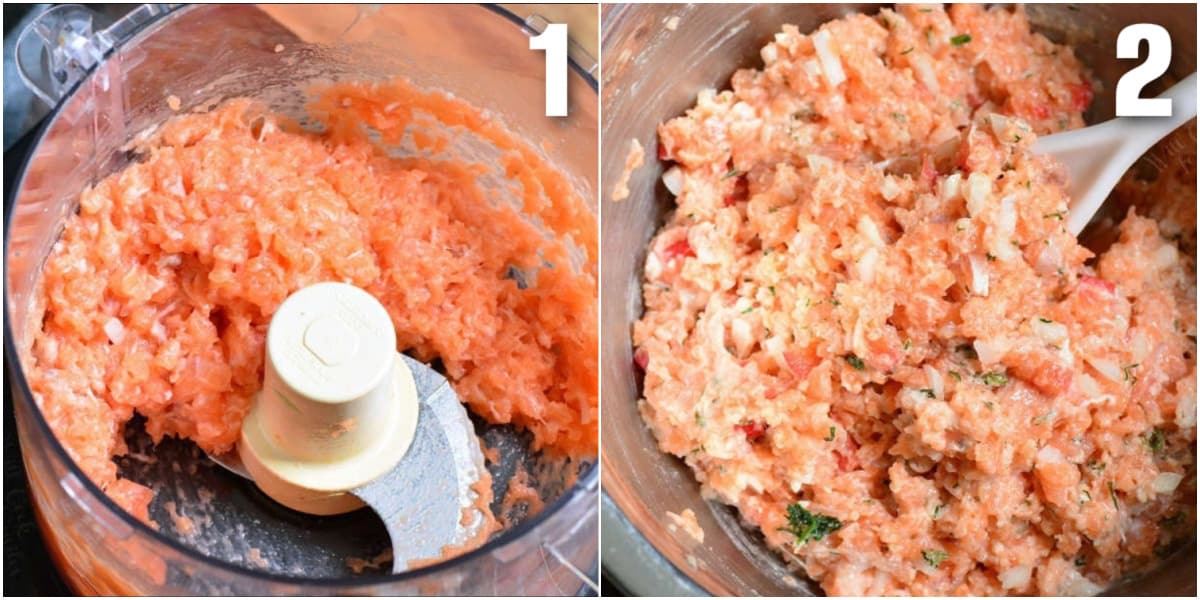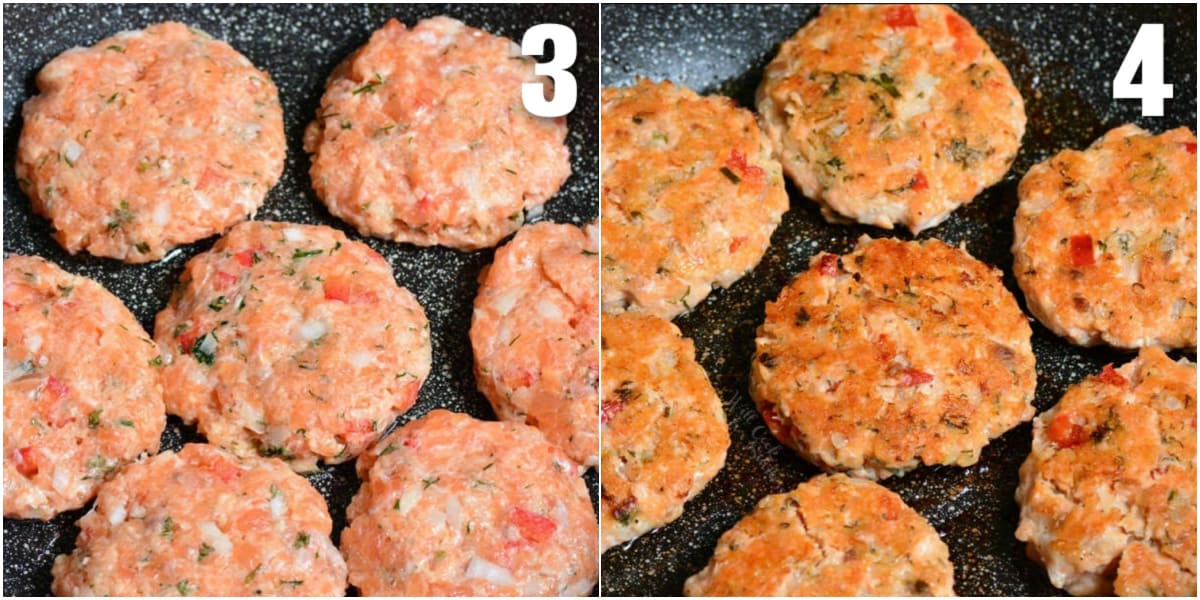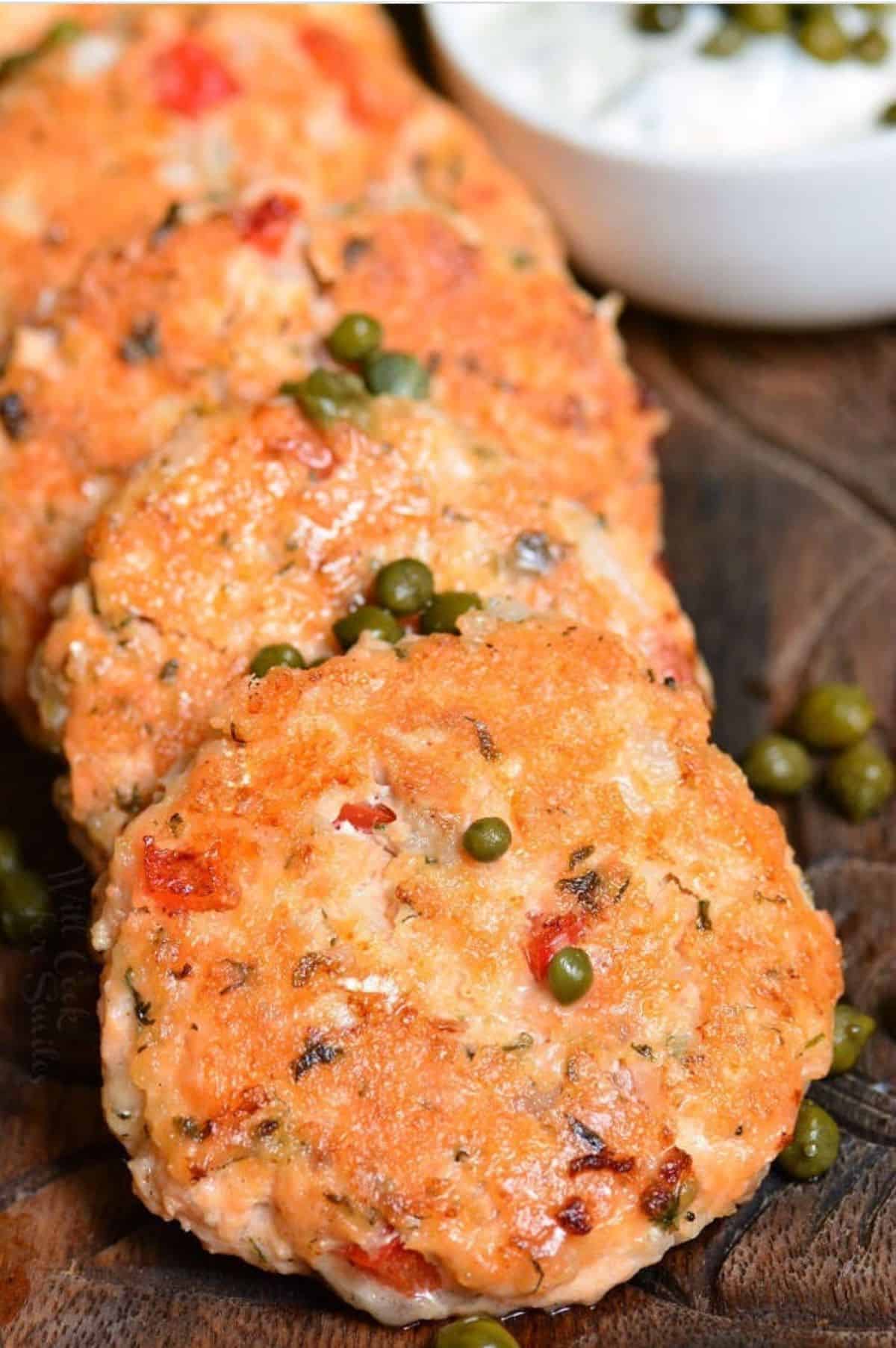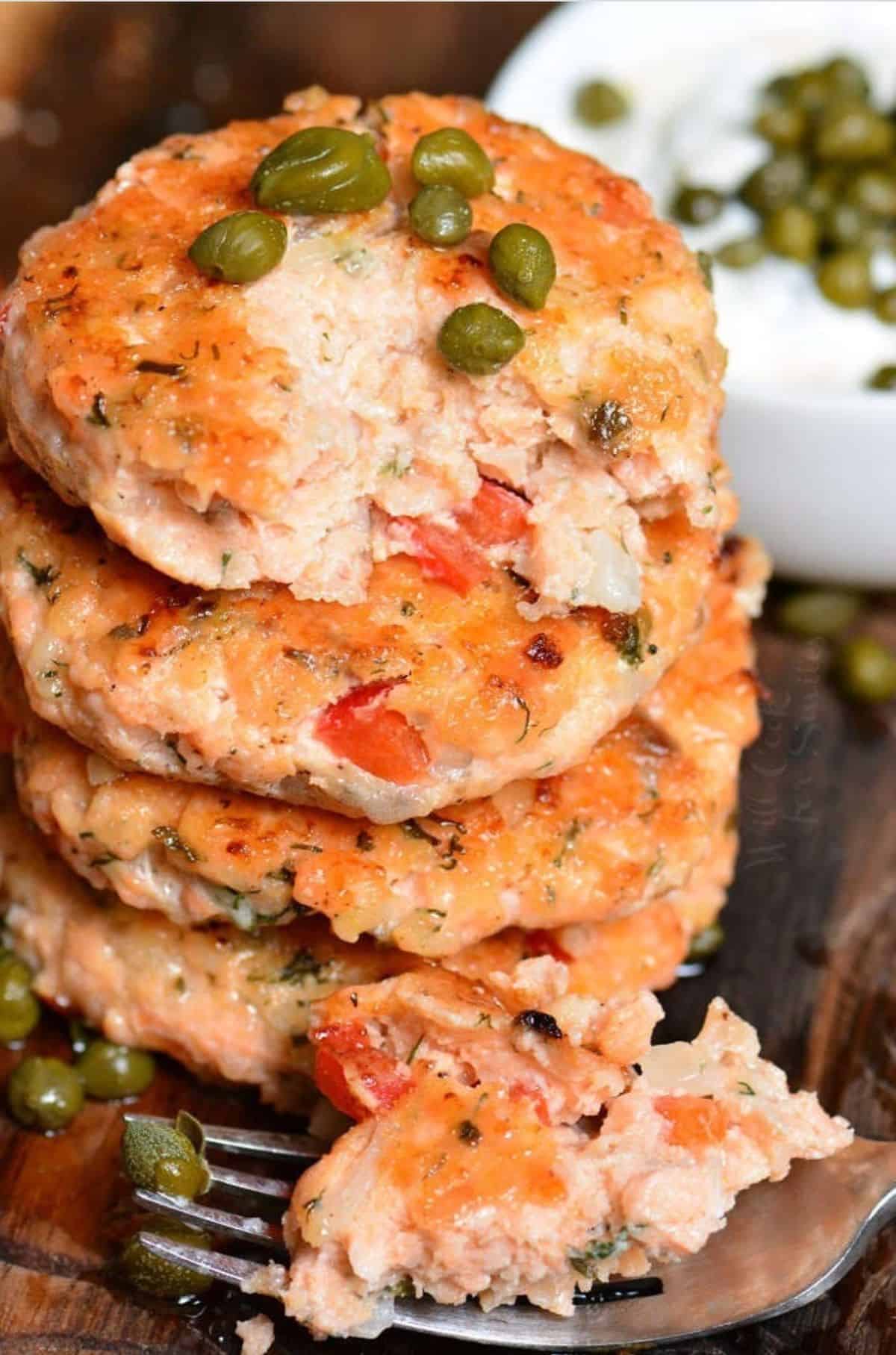Fresh salmon, onions, peppers, herbs, lemon juice, and a few other tasty things are used to make juicy, tender Salmon Patties. This is an easy summer recipe that always works. You can even make extra and freeze some salmon patties for later.
That’s right, these salmon patties are going to become your new summer favorite! The best flavor comes from fresh salmon, which is then paired with other tasty ingredients. Fresh herbs, freshly squeezed lemon juice, Dijon mustard and more help to do just that.
This recipe can be made with either raw salmon or salmon that has been baked first. The main difference between using raw or cooked salmon is the texture. When salmon is cooked first, the texture is more flaky. When salmon is used raw, it’s more of little pieces than flakes.
Salmon patties always turn out so juicy, tender, and flavorful. I like to add capers on top to make them extra tasty. I enjoy making them all year, but I love making them in the summer because they are so light and fresh. They go well with roasted vegetables, in a sandwich, or on top of a bed of greens.
Salmon: Fresh salmon is best, but you can use frozen salmon filets if you have to. Just make sure to let them thaw all the way in the fridge before making the patties.
Herbs – Fresh parsley and dill weed are what create the subtle, yet mouthwatering herbaceous flavor here. I don’t recommend using dried herbs as you won’t achieve the same fresh flavor.
Lemon Juice: Real lemon juice that has just been squeezed is the best! Don’t use anything from a bottle or a concentrate.
To keep the other flavors from being too strong, I like to use just a pinch of salt and freshly ground black pepper.
Salmon patties are a tasty way to enjoy fish However, like many foods, they don’t retain their just-made texture after refrigerating or freezing Fortunately, with a few tricks, you can resurrect leftover salmon patties to their former crispy glory.
As a busy home cook and food blogger I rely on make-ahead meals like salmon patties. Taking time to properly reheat them pays dividends in preserving that delicious crispy crust. Read on for my tips to revive refrigerated or frozen salmon cakes so they taste freshly fried.
Why Proper Reheating Matters
You put care into cooking moist, tender salmon patties coated in a crispy, golden breadcrumb crust. Unfortunately, the crispiness fades as the patties sit in the fridge or freezer Why does this happen?
The culprits are moisture and cooled oil. As salmon patties refrigerate, condensation softens the crust. Meanwhile, the once hot oil coating the exterior cools and seeps in, leaving a softened layer.
Simply microwaving or eating cold, softened salmon cakes is a disservice to your original creation. The texture suffers tremendously.
So, if you want to enjoy salmon patties at their best, you need to take steps to bring the outside back to life and recrisp it. You can crisp up patties that have been in the fridge or defrost and crisp ones that have been frozen if you know how to reheat them correctly.
Tips for Reheating Refrigerated Salmon Patties
For salmon cakes that have been in the fridge, you want to bring the crust back to life without cooking the already cooked inside too much. Here are my tips:
-
Let patties sit out for 10-15 minutes before reheating. This helps dry the exterior.
-
Reheat using high heat methods like sautéing, broiling, or air frying. Avoid the microwave.
-
Use a hot pan or oven. Preheat your cooking vessel fully before adding patties.
-
Use a touch of oil or cooking spray to help recreate the fried texture.
-
Cook patties in batches. Avoid crowding to allow surfaces to crispen.
-
Heat through fully, about 8-10 minutes in a 375°F oven.
-
Turn patties over halfway for even browning.
-
Check internal temperature using a thermometer to confirm they’re hot.
Follow these guidelines to bring refrigerated salmon patties back to life with a crisp, golden crust.
Best Methods for Reheating Refrigerated Salmon Patties
While the stovetop, oven, and air fryer all effectively reheat refrigerated salmon cakes, I recommend:
1. Pan-Sautéing
-
Heat 1 tsp oil in a nonstick skillet over medium-high heat.
-
Add patties in a single layer. Sauté 3-4 minutes per side.
-
Take care not to break patties when flipping. Crust should be crispy.
Sautéing is quick and gives you the most control over browning.
2. Oven Baking
-
Preheat oven to 375°F. Line a baking sheet with foil or parchment.
-
Arrange patties on sheet without crowding. Brush tops lightly with oil.
-
Bake 8-10 minutes until heated through and crust is crispy.
The oven allows for easy batch reheating and hands-off crisping.
3. Air Frying
-
Preheat air fryer to 380°F.
-
Place patties in air fryer basket in a single layer.
-
Cook 3-4 minutes, until hot. Flip and cook another 1-2 minutes.
The hot circulating air crisps up the crust nicely. Watch closely to avoid overcooking.
While the microwave seems convenient, it makes the crust soggy and limp. Always opt for reheating methods that recrisp the exterior.
Tips for Reheating Frozen Salmon Patties
Reheating frozen salmon patties requires first thawing them out gently to avoid overcooking the centers. Here are my tips:
-
Thaw patties overnight in the fridge or use the defrost setting on a microwave.
-
Let patties sit at room temperature for 10-15 minutes after thawing.
-
Pat off any condensation and moisture with paper towels before reheating.
-
Use a hot skillet, oven, or air fryer to reheat until hot and crispy.
-
Add a teaspoon of oil or cooking spray to the reheating vessel to help recrisp.
-
Watch patties closely and flip halfway through for even reheating.
Follow this process of gentle thawing and dry reheating to successfully revive frozen salmon cakes.
Best Methods for Reheating Frozen Salmon Patties
To reheat frozen salmon cakes back to their original glory, I suggest:
1. Air Fryer
-
Thaw salmon patties overnight in the fridge.
-
Pat dry with paper towels and let sit out 10-15 minutes.
-
Preheat air fryer to 380°F.
-
Air fry 3-4 minutes until hot and crispy, flipping halfway.
The hot air circulating in the air fryer does a great job of crisping up the crust uniformly.
2. Oven Bake
-
Thaw patties in the fridge then pat dry.
-
Preheat oven to 375°F. Line a baking sheet with foil.
-
Arrange on sheet. Brush tops lightly with oil.
-
Bake 8-10 minutes until heated through with a crisped crust.
The dry, ambient heat of the oven recrisps the surface while heating through.
3. Skillet Sauté
-
After fridge thawing, dry patties well with paper towels.
-
Heat 1 tsp. oil in a nonstick skillet over medium-high heat.
-
Sauté patties 3-4 minutes per side until hot and crispy.
Sautéing gives you control over browning, but cook patties in batches.
Avoid microwaving thawed salmon patties, as it ruins texture. Use high heat to revive the crust instead.
Serving Reheated Salmon Patties
Once your reheated salmon cakes have a crisp, golden-brown crust, try serving them:
-
On soft buns with lettuce, tomato, and tartar sauce for salmon burgers.
-
Over fresh greens or grain bowls for a protein boost.
-
With eggs for a hearty breakfast or brunch.
-
Alongside coleslaw, potato salad, or pasta salad.
-
Topped with remoulade, salsa, or avocado for flavor.
-
On crackers or toast points as appetizers.
However you enjoy them, properly reheated salmon patties deliver plump, moist fish enrobed in a shatteringly crisp crust. Much better than a soggy, soft reheated cake!
Storing Leftover Salmon Patties
Have leftover reheated salmon patties? Follow these storage tips:
-
Let patties cool completely before storing.
-
Place in a storage container or resealable plastic bag.
-
Refrigerate for up to 4 days.
-
Double wrap and freeze for 1-2 months. Thaw before reheating.
-
Add parchment between patties to keep from sticking if layering.
With proper storage and reheating, you can enjoy crisp, delicious salmon cakes all week long!
Troubleshooting Reheated Salmon Patties
If your reheated patties aren’t living up to their original glory, here are some troubleshooting tips:
Patties fall apart
-
Let patties cool completely before storing or reheating. Hot patties are fragile.
-
Avoid overmixing the salmon filling. Delicate mixing leaves chunks that bind better.
Inner texture is dry
-
Don’t overcook initially or when reheating. Cook just until opaque in center.
-
Add mayo or sour cream to the salmon filling. The fat keeps patties moist.
Breading is soggy
-
Pat off moisture before reheating and let sit out 10-15 minutes.
-
Use high heat reheating methods to recrisp and avoid microwave.
Follow these tips and your reheated salmon cakes will be seriously crispy and delicious!
Enjoy the Crispy Comfort of Salmon Patties
With a bit of forethought, you can enjoy the crispy, golden comfort of homemade salmon patties all week long.
Proper storage, gentle reheating, and techniques to recrisp the crust allow you to resurrect refrigerated or frozen patties to their initial glory. Savor the plump salmon flavor within the shatteringly crisp, panko-coated exterior.

How to Make Salmon Patties

Cut the filets into big chunks, then put them in the food processor and pulse a few times.
Dice the shallot and bell pepper into small pieces. Combine the salmon, diced veggies, and all other ingredients in a mixing bowl until combined (2).
Use an ice cream scoop and greased hands to form the patties (3). Preheat a large pan over medium heat with some canola oil.
Cook the salmon patties in the pan for about 7 minutes per side (4).

Once cooled to room temperature, store salmon patties in an airtight container in the refrigerator for 3-4 days. It’s best reheated them in a pan over medium-low heat. Seafood, in general, is not good to reheat in the microwave so try to avoid that. Preheat the cooking pan first and then add the salmon patties. If the pan is non-stick, you may not need additional oil for the pan. Cover the pan with a lid and reheat them on both sides just until heated through.
One of the most popular ways to enjoy these patties is to place them in a burger/sandwich. I recommend soft, smaller buns like Brioche because these salmon patties are delicate. Put lettuce, tomato, and tartar sauce on top, and enjoy every bite! My Grilled Salmon Burger recipe and the classic Salmon Burger recipe give you some ideas. ) Serve these salmon patties with a variety of side dishes for dinner. Serve it with your favorite sides like roasted vegetables, asparagus, side salads, mashed potatoes, or roasted potatoes. As a sauce, pair it with tartar sauce, remoulade, capers, or even homemade ranch dressing.
There are a couple of reasons the patties might fall apart: not enough binder or the cooking pan. The binders include bread crumbs, milk soaked bread, crushed crackers, mayo, and eggs. When making salmon patties with raw salmon, I don’t like to add the egg because it makes the patties too watery. Mayo and bread crumbs have been enough. One of the biggest reasons the patties might fall apart is the pan. Some issues could be that the pan is scratched, not clean enough, not non-stick, or there isn’t enough oil.

To freeze them uncooked:
Place shaped patties on a parchment paper lined baking sheet and place the sheet in the freezer. Freeze for 2 hours. Make sure to set the timer or you might forget them.
Take the frozen patties off the tray and stack them two high with a piece of parchment paper between each pair. Place stacks of patties into a freezer bag or divide them in portions among several smaller freezer bags. Get all the air out, seal, label, and freeze for up to 3 months.
To freeze them cooked:
Place cooked and cooled salmon patties on a baking sheet lined with parchment paper. Freeze them for 2 hours and make sure to set the timer so you don’t forget. Once frozen, place the patties into the freezer bags all together or in portions. Get all the air out, seal, label, and freeze for up to 3 months.
To thaw:
Take the bag of frozen patties from the freezer and place it in the refrigerator. Thaw in the refrigerator overnight.

Cutting Board – use plastic cutting board when working with raw meats!
